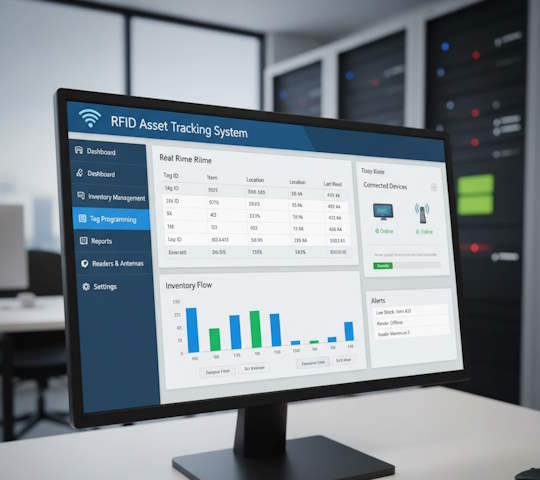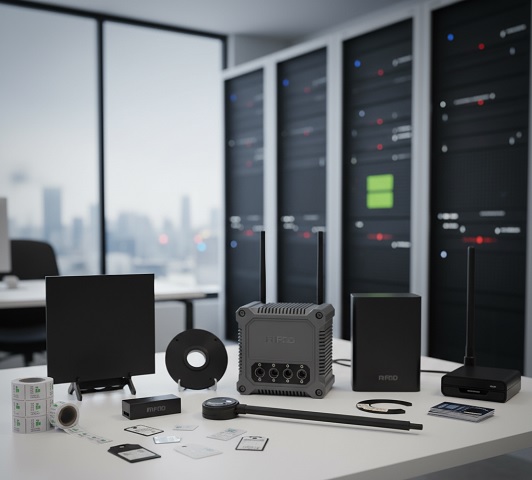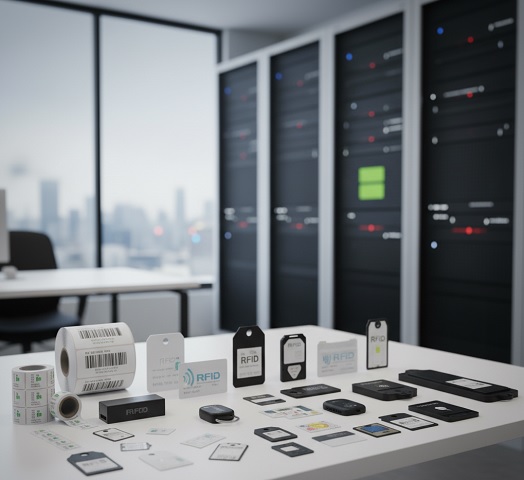RFID in Retail: From Inventory Accuracy Enhancement to Customer Experience Transformation
Executive Summary
Modern retail faces unprecedented challenges: escalating customer expectations for product availability, the shift to omnichannel operations, and the imperative to optimize operational costs while maintaining competitive margins. Under these conditions, Radio Frequency Identification (RFID) technology is experiencing a renaissance, evolving from a basic inventory automation tool into a strategic technology that directly impacts financial performance and competitive positioning.
According to Grand View Research¹, the global RFID retail market demonstrates robust growth with a 12.3% CAGR, projected to increase from $3.2 billion in 2023 to $8.9 billion by 2030. This growth reflects massive adoption by industry leaders who have proven the technology's ROI and strategic value. This comprehensive analysis explores how RFID deployment enables retailers to achieve unprecedented data accuracy, reduce shrinkage, and create new opportunities for customer engagement while delivering measurable business results.
Technology Foundation: Why RFID Outperforms Barcodes
RFID systems comprise three core components: tags, readers, and data processing software. Modern solutions are built on the EPCglobal UHF Class 1 Gen 2 standard, developed by GS1², ensuring global compatibility and reliable system performance across diverse operational environments.
Unlike barcodes that require direct line-of-sight and manual scanning, RFID tags enable simultaneous identification of hundreds of items at distance without the need to unpack boxes or handle individual products, fundamentally transforming inventory management workflows.
Comparative Analysis: RFID vs. Barcode Technology
| Specification | RFID | Barcode |
|---|---|---|
| Line-of-sight requirement | Not required | Mandatory |
| Scanning speed | Hundreds of items per second | Individual item scanning |
| Data storage capacity | High (up to 8 KB) | Limited (up to 100 bytes) |
| Read range | Up to 12 meters (passive tags) | Several centimeters |
| Damage resistance | High | Low |
| Data rewriting capability | Yes | No |
| Cost per unit | $0.05-0.15 | $0.001-0.01 |
| Labor requirement | Minimal | High |
Critical for global retail operations is adherence to international data encoding standards, particularly the SGTIN-96 (Serialised Global Trade Item Number) schema developed by GS1³. This ensures data compatibility across the entire supply chain — from manufacturer to store shelf — enabling seamless integration with existing enterprise systems.
Business Case: Quantified Benefits for Retail Operations
RFID implementation represents a strategic investment with clear financial justification rather than merely a technical upgrade. Research by Zebra Technologies⁴ indicates that 73% of retailers plan to increase RFID investments over the next two years, with average ROI reaching 21% within the first year of deployment.
Key Performance Drivers:
Inventory Accuracy up to 99%: Traditional methods deliver 65-75% accuracy. RFID elevates this to 98-99%, providing the foundation for omnichannel services such as Buy Online, Pick up In Store (BOPIS) and ship-from-store fulfillment⁵.
Shrinkage Reduction: According to the National Retail Federation (NRF)⁶, annual retail losses reached $112.1 billion in 2022. RFID combats shrinkage through:
- Rapid identification of missing inventory
- Deterrent effect on theft activities
- Enhanced supply chain visibility and control
- Real-time exception reporting and alerts
Operational Efficiency: Inventory processes that previously required days are completed in hours. Full store cycle counts that traditionally took 40+ hours are reduced to 2-3 hours, delivering labor cost savings of $50,000-$100,000 annually for typical retail locations.
Revenue Protection: Out-of-stock situations, which cost retailers an average of 4% of sales, are minimized through real-time inventory visibility and automated replenishment triggers.
Case Studies: Proven Implementations in Global Retail
Leading international retailers have integrated RFID into their core operations with measurable, documented results that demonstrate clear competitive advantages.
Zara (Inditex Group)
Since 2014, the company has implemented RFID on 100% of apparel inventory⁷. Key performance outcomes:
- Bi-weekly inventory cycles completed in 2-3 hours
- 99% inventory data accuracy across all locations
- Same-day order fulfillment capability enabled
- 40% reduction in shelf replenishment time
- Enhanced customer satisfaction through improved product availability
Decathlon
The French sporting goods retailer has revolutionized the checkout process⁸:
- Customers place items on scanning surface for instant recognition
- Simultaneous scanning of all items in basket
- Automatic deactivation of security tags
- 70% reduction in checkout processing time
- Significant improvement in customer experience metrics
Lululemon
The Canadian athletic apparel chain achieved exceptional results⁹:
- Implementation across 500+ store locations
- 98% inventory accuracy maintained consistently
- ROI achieved in less than 12 months
- Flexible order fulfillment from any network location
- Enhanced pandemic resilience through inventory flexibility
Technology Trends and Retail Mandates
RFID is transitioning from optional technology to business necessity. Major retailers are implementing mandatory requirements for suppliers:
Current Industry Mandates:
- Walmart: RFID tagging requirements for specific product categories¹⁰
- Target: Phased implementation of supplier RFID mandates
- Macy's: 100% tagging of fashion merchandise categories
- Costco: RFID requirements for select high-value categories
Emerging Technology Integration:
Smart Fitting Rooms:
- Automatic detection of brought-in merchandise
- Alternative size and color recommendations
- Personalized styling suggestions based on selections
- Enhanced customer engagement and conversion rates
Frictionless Checkout:
- Amazon Go technology and similar solutions
- Automatic billing upon store exit
- Complete elimination of traditional checkout queues
- Significant operational cost reduction
Anti-Counterfeiting:
- Unique identification for each product unit
- Real-time authenticity verification
- Critical for luxury goods and pharmaceuticals
- Brand protection and consumer safety enhancement
Implementation Considerations and Financial Modeling
Investment Requirements (Typical 10,000 sq ft store):
- RFID Tags: $2,000-5,000 monthly operational cost
- Readers and Antennas: $15,000-25,000 capital investment
- Software Licensing: $10,000-20,000 plus integration costs
- Staff Training: $3,000-5,000 initial investment
- Total Initial Investment: $30,000-55,000 plus ongoing operational expenses
ROI Analysis and Payback:
- Payback Period: 12-18 months for typical implementations
- First-Year ROI: 15-25% based on operational improvements
- Primary Value Sources: Shrinkage reduction, labor optimization, sales increase
- Long-term Benefits: Enhanced omnichannel capabilities, improved customer experience
Implementation Timeline:
Phase 1: Assessment and Planning (4-6 weeks)
- Current state analysis and gap identification
- ROI modeling and business case development
- Vendor selection and contract negotiation
Phase 2: System Design and Procurement (6-8 weeks)
- Technical architecture design
- Hardware specification and procurement
- Software customization and integration planning
Phase 3: Installation and Testing (4-6 weeks)
- Hardware deployment and configuration
- System integration and data flow validation
- User acceptance testing and performance verification
Phase 4: Rollout and Training (2-4 weeks)
- Staff training and change management
- Phased production deployment
- Performance monitoring and optimization
Future Technology Evolution
Edge Computing Integration
Advanced implementations incorporate edge computing capabilities, enabling real-time analytics and decision-making at the store level without dependence on cloud connectivity, crucial for maintaining operations during network disruptions.
AI-Powered Analytics
Machine learning algorithms analyze historical traffic patterns, seasonal trends, and customer behavior to predict demand, optimize inventory allocation, and enhance operational efficiency through predictive insights.
Blockchain Integration
Emerging implementations integrate blockchain technology for immutable product tracking, particularly valuable for organic products, luxury goods, and pharmaceutical items requiring enhanced traceability and authenticity verification.
Conclusion
RFID implementation in retail has evolved from inventory optimization tool to a cornerstone of digital transformation and competitive differentiation. Alignment with international GS1 standards and proven success patterns from global leaders like Zara, Decathlon, and Lululemon demonstrate tangible results: revenue growth up to 5%, operational cost reduction of 10-15%, and creation of differentiated customer experiences.
For modern retailers, RFID investment represents not merely a competitive advantage but a necessity for survival and growth in the omnichannel economy. The convergence of retail mandates, decreasing technology costs, and proven ROI models makes 2024-2025 the optimal timeframe for RFID adoption.
The technology has matured beyond early adoption phases, with extensive vendor ecosystem support, standardized implementation methodologies, and measurable business outcomes making deployment both feasible and financially attractive for retailers of all scales.
Frequently Asked Questions (FAQ)
Implementation and Strategy
What is the typical implementation timeline for retail RFID?
A complete single-store implementation requires 6-12 weeks:
- Planning and system design: 2-3 weeks
- Equipment installation: 1-2 weeks
- System integration with existing platforms: 2-4 weeks
- Testing and staff training: 1-3 weeks
What inventory accuracy levels are achievable with RFID?
Modern RFID systems deliver 98-99% inventory accuracy compared to 65-75% with traditional methods. This precision enables reliable omnichannel operations and prevents lost sales due to inventory misallocations.
What ROI can retailers expect from RFID implementation?
Average first-year ROI ranges from 15-25%. Primary revenue sources include:
- Shrinkage reduction of 2-5%
- Sales increase of 1-3% through improved product availability
- Labor cost reduction of 80-90% for inventory-related tasks
Technical Specifications
Which product categories are optimal for RFID tagging?
Highest-value categories include:
- Apparel and footwear (high margins, frequent inventory turns)
- Electronics (high value, theft risk)
- Cosmetics and fragrances (compact size, premium pricing)
- Jewelry and watches (high value, anti-counterfeiting needs)
Do metal surfaces interfere with RFID performance?
Yes, metal can cause interference, but modern solutions include:
- Specialized tags designed for metal applications
- Reader power optimization and tuning
- Strategic antenna placement and orientation
- Circularly polarized antennas for improved performance
Which RFID standard should retailers adopt?
Recommended standard is EPCglobal UHF Class 1 Gen 2 (ISO 18000-63):
- Global compatibility across all major vendors
- Support from leading equipment manufacturers
- SGTIN-96 standard for product identification
- Operating frequency 860-960 MHz (region-dependent)
Operational Impact
How does RFID affect checkout processing speed?
Dramatic acceleration of checkout processes:
- Traditional barcode scanning: 2-3 seconds per item
- RFID scanning: All items simultaneously in 1-2 seconds
- Decathlon example: 70% reduction in checkout time
- Enhanced customer satisfaction and throughput
Is extensive staff retraining required for RFID systems?
Minimal training requirements:
- RFID scanner operation: 2-4 hours
- Inventory procedures: 4-8 hours
- Software system navigation: 8-16 hours
- Total training time: 1-2 working days per employee
How does RFID support loss prevention strategies?
Multi-layered theft deterrence:
- Automated tracking of product movements
- Real-time alerts for unauthorized removals
- Detailed shrinkage analytics by category and timeframe
- Integration with video surveillance systems
Integration and Compatibility
Does RFID integrate with existing POS and ERP systems?
Yes, through standard protocols:
- REST APIs for cloud-based solutions
- SOAP/XML for legacy system integration
- Direct integration with SAP, Oracle, Microsoft Dynamics
- Support for standard data formats (EPCIS, JSON)
Can RFID support omnichannel operations?
RFID is fundamental to omnichannel success:
- Accurate inventory visibility across all channels
- Order fulfillment from any network location
- Reliable Buy Online, Pick up In Store (BOPIS) operations
- Unified real-time inventory representation
How is RFID data security and privacy maintained?
Enterprise-grade security measures:
- Tag data encryption (AES-128/256)
- Reader authentication protocols
- Application-level access controls
- GDPR and privacy regulation compliance features
Financial and Strategic Considerations
What are the ongoing operational costs for RFID?
Typical monthly operational expenses:
- RFID tags: $0.05-0.15 per unit (varies by volume)
- Software licensing: $500-2,000 per store location
- Maintenance and support: 10-15% of initial hardware investment
- Tag replacement: 3-5 year lifecycle for reusable applications
How do retail mandates affect supplier relationships?
Strategic partnership implications:
- Enhanced visibility and collaboration with compliant suppliers
- Potential for preferred vendor status and better terms
- Shared benefits through improved supply chain efficiency
- Long-term competitive advantage through early adoption
What financing options are available for RFID implementation?
Multiple funding approaches:
- Capital expenditure with internal funding
- Technology leasing arrangements
- Vendor financing programs
- ROI-based performance contracts with system integrators
Future Technology Integration
How does RFID integrate with emerging technologies?
Convergence with advanced platforms:
- IoT sensors for environmental monitoring
- AI/ML for predictive analytics and demand forecasting
- Computer vision for enhanced customer insights
- Blockchain for supply chain transparency and authenticity
What is the future evolution path for retail RFID?
Next-generation capabilities:
- Augmented reality integration for enhanced shopping experiences
- Advanced analytics for personalized marketing
- Autonomous inventory management systems
- Enhanced sustainability tracking and reporting
How does RFID support sustainability initiatives?
Environmental and social impact:
- Reduced paper-based processes and documentation
- Optimized inventory levels reducing waste
- Enhanced product lifecycle tracking
- Supply chain transparency for ethical sourcing verification
References
- Grand View Research. "RFID Market Size, Share & Trends Analysis Report By Product, By Application, By Region And Segment Forecasts, 2023-2030". https://www.grandviewresearch.com/industry-analysis/radio-frequency-identification-rfid-market
- GS1. "EPCglobal UHF Class 1 Generation 2 Standard". https://www.gs1.org/standards/epc-rfid
- GS1. "SGTIN-96: Serialised Global Trade Item Number". https://www.gs1.org/standards/id-keys/gtin
- Zebra Technologies. "Retail Vision Study: The Future of Fulfillment". https://www.zebra.com/us/en/about-zebra/newsroom/press-releases/retail-vision-study.html
- Auburn University RFID Lab. "Chain Integration Project (CHIP)". https://www.auburn.edu/research/rfid-lab/
- National Retail Federation. "2023 National Retail Security Survey". https://nrf.com/research/2023-national-retail-security-survey
- Based on publicly available information regarding Inditex Group RFID implementations, 2014-2024.
- Based on publicly available information regarding Decathlon technological solutions, 2020-2024.
- Based on publicly available information regarding Lululemon digital transformation, 2019-2024.
- Walmart. "RFID Mandate Guidelines for Suppliers". https://www.walmartsustainabilityhub.com/supply-chain




